What a Sales Enablement Job Actually Looks Like


Introduction
The B2B sales landscape transformed overnight. Sales teams drowning in tools they don't know how to use. Reps sending cold emails that land in spam. Revenue targets missed because nobody aligned marketing content with sales conversations.
This chaos created one of the fastest-growing roles in B2B: sales enablement.
Sales enablement jobs aren't just about training. They're about building the infrastructure that turns average sales teams into revenue-generating machines. If you're considering a career in sales enablement or hiring for this role, you need to understand what these jobs actually involve, what skills matter, and how the role evolves as you scale.
This guide breaks down everything you need to know about sales enablement jobs in 2025, from entry-level positions to executive roles, including the tools you'll use, the skills you'll need, and what you can expect to earn.
What Is Sales Enablement and Why Does It Matter?
Sales enablement is the process of providing sales teams with the content, tools, training, and processes they need to engage buyers effectively and close deals faster.
Think of sales enablement as the operations team behind every successful sales organization.
While sales reps focus on conversations and closing deals, sales enablement professionals ensure those reps have everything they need to succeed.
The numbers tell the story. Companies with dedicated sales enablement see 49% higher win rates on forecasted deals and achieve 38% higher sales win rates overall. Organizations that invest in enablement also experience 15% higher quota attainment compared to those without formal enablement programs.
Sales enablement became critical because B2B buying changed. Buyers now complete 57% of their purchase decision before ever talking to a sales rep. They research online, compare alternatives, and form opinions before your team gets a chance to present. Sales enablement ensures your team can engage these informed buyers with relevant, personalized content at exactly the right moment.
Daily Responsibilities and What a Sales Enablement Job Actually Looks Like
Sales enablement isn't a desk job with predictable routines. Your days vary based on team needs, current initiatives, and organizational priorities. Here's what a typical week actually involves.
Monday: Strategy and Planning
Monday often focuses on planning and alignment. You'll attend sales leadership meetings to understand current challenges and priorities. Revenue review meetings show you where deals are stuck and what support sales teams need.
You'll analyze data from the previous week, identifying trends in win rates, content usage, and training completion. This analysis informs your priorities for the week ahead.
If you're managing a team, Monday includes your weekly enablement standup where you align on projects, remove blockers, and ensure everyone knows their key deliverables.
Tuesday and Wednesday: Execution and Creation
Mid-week shifts to execution. You're creating content, developing training programs, and implementing initiatives that directly support sellers.
Content creation might involve writing a new battle card for a competitive situation that's appeared in multiple deals, updating case studies with recent customer wins, or creating proposal templates that accelerate deal closure.
Training development includes designing new hire onboarding modules, building certification programs for new product launches, or recording coaching videos that address common objections.
You'll also conduct live training sessions. These might be product deep-dives with subject matter experts, role-playing exercises where reps practice discovery calls, or workshops on specific sales techniques.
Technology work happens mid-week too. You're configuring new tools, setting up automation in platforms like Smartlead or Lemlist, troubleshooting integration issues, or working with sales ops to improve CRM workflows.
Thursday: Coaching and Field Work
Thursday often involves direct work with sales teams. You'll join discovery calls to observe rep performance and provide coaching, listen to recorded calls using tools like Fireflies AI to identify improvement opportunities, conduct one-on-one coaching sessions with reps who need extra support, and run deal review sessions where you help strategize next steps on complex opportunities.
Field work keeps you connected to real selling challenges. You understand which training translates to actual behavior change, which content reps actually use versus what sits unused, and where processes create friction instead of helping close deals.
This connection to reality makes your enablement work practical and actionable rather than theoretical.
Friday: Analysis and Stakeholder Communication
Friday typically focuses on reporting and stakeholder management. You'll compile metrics on enablement program performance, prepare reports for sales leadership showing progress against goals, update project timelines and communicate status to stakeholders, and document lessons learned from the week.
You'll also spend time on strategic projects that require focused work, like developing next quarter's enablement roadmap, planning major initiatives like new product launches, or building business cases for additional enablement resources.
Ad-Hoc Responsibilities Throughout the Week
Beyond scheduled activities, enablement involves constant ad-hoc work responding to urgent needs.
A rep needs help preparing for a critical presentation. You drop what you're doing to review their deck and provide feedback.
Marketing launches new messaging. You quickly create training materials so sales can use the new positioning.
Product announces a feature update. You coordinate a rapid enablement push including documentation, training, and updated sales materials.
Sales leadership identifies a skill gap in objection handling. You design and deploy a quick coaching program to address it.
This reactive work tests your ability to prioritize ruthlessly and manage competing demands. The best enablement professionals balance proactive strategic work with responsive support, ensuring sales teams get what they need when they need it.
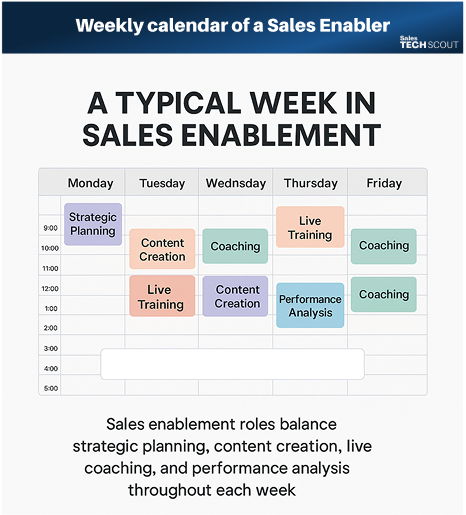
Tools and Technology Every Sales Enablement Professional Should Know
Your effectiveness in sales enablement correlates directly with your mastery of the sales technology stack. These platforms help you scale your impact, measure your results, and continuously improve enablement programs.
Customer Relationship Management (CRM)
Your CRM serves as the foundation for enablement. Every interaction, every deal, every customer lives here. You'll use CRM data to identify coaching opportunities, track content usage, and measure program impact.
Attio offers a flexible CRM designed for modern sales teams. Its customizable workflows let you adapt the system to your sales process rather than forcing your process to fit the tool.
Close focuses on sales-first functionality with built-in calling, email, and SMS capabilities. This integrated approach helps reps work more efficiently without jumping between platforms.
folk connects your CRM to your entire sales stack, synchronizing data across platforms and eliminating manual data entry that wastes selling time.
Your CRM choice impacts how easily you can extract insights, track seller behavior, and measure enablement effectiveness. Look for platforms with robust reporting, clean data structure, and strong API connections to other tools.
Sales Engagement and Outreach Platforms
Sales engagement tools help reps execute consistent, scalable outreach across email, LinkedIn, and phone. These platforms enforce best practices, ensure message consistency, and provide data on what actually works.
Smartlead enables cold email campaigns with unlimited inboxes, helping teams avoid deliverability issues while scaling outreach volume. Its AI-powered features help optimize send times, subject lines, and follow-up sequences.
Lemlist provides multi-channel outreach combining email, LinkedIn, and phone in coordinated sequences. This omnichannel approach increases response rates by reaching prospects through their preferred communication method.
Emelia offers similar multi-channel capabilities with strong deliverability infrastructure and built-in LinkedIn scraping tools.
As an enablement professional, you'll work with these platforms to create template libraries, design best-practice sequences, and train reps on effective outreach strategies. You'll also analyze engagement data to identify which messages resonate and which fall flat.
Data Enrichment and Lead Intelligence
Sales teams need accurate, comprehensive data on prospects and accounts. Data enrichment tools automate the research that used to consume hours of selling time.
Prospeo provides B2B email and phone data, helping reps quickly build targeted prospect lists without manual research, integrated in Clay.
Enrow provides B2B emails, phone data and email verification to build great prospect lists, integrated in Clay.
FullEnrich uses waterfall enrichment, checking multiple data sources sequentially to maximize data coverage and accuracy. This approach fills gaps that single-source providers miss.
LeadMagic offers additional enrichment for both email and phone contact information, expanding your data coverage.
Ocean.io helps find lookalike accounts based on your best customers, making it easier to build targeted prospect lists that match your ideal customer profile.
These tools integrate with your CRM and outreach platforms, automatically enriching contact records and ensuring reps always work with current, accurate information.
Content Management and Sales Collateral
Sales teams need quick access to relevant content. Content management platforms organize your materials, track usage, and recommend the right assets for specific situations.
Many companies use specialized sales content management systems, but simpler solutions also work. Cloud storage like Google Drive or Dropbox combined with clear naming conventions and folder structures provides basic organization.
The key is making content discoverable. Tag materials by use case, buyer persona, sales stage, product line, and content type. Train reps on how to search effectively, and regularly audit usage to identify gaps where needed content doesn't exist.
Learning Management Systems (LMS)
LMS platforms deliver training content, track completion, and assess knowledge retention. You'll use these systems to onboard new hires, roll out product updates, and run ongoing skill development programs.
Look for platforms with video hosting capabilities, quiz and assessment features, progress tracking and reporting, mobile accessibility for on-the-go learning, and integration with your CRM and HR systems.
Many enablement teams also supplement formal LMS with communication platforms like Slack or Microsoft Teams where they share quick tips, celebrate wins, and maintain continuous learning conversations.
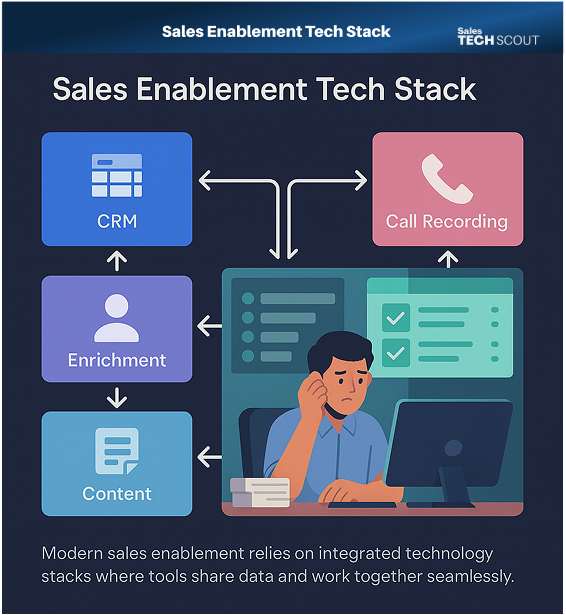
Call Recording and Conversation Intelligence
Understanding what actually happens on sales calls guides your coaching priorities and training content. Call recording platforms capture, transcribe, and analyze sales conversations at scale.
Fireflies AI automatically joins meetings, records conversations, generates transcripts, and extracts key insights. Its AI summaries save hours of manual note-taking and make it easy to review multiple calls quickly.
Fathom provides similar functionality with strong emphasis on user experience and privacy. Its highlight reel feature lets you quickly create coaching moments from longer calls.
These tools help you identify patterns in successful calls, spot common objections that need better training, and provide specific, actionable feedback to reps based on their actual conversations.
Email Deliverability Infrastructure
Cold email only works if messages reach inboxes. Email infrastructure tools ensure your outreach campaigns maintain strong deliverability rates.
Maildoso provides web domains and email accounts specifically optimized for outreach, with infrastructure designed to maximize inbox placement.
Zapmail provides host Google workspace and Microsoft email accounts + web domains. Easily integrates into multiple outreach tools.
As enablement, you'll work with sales operations to ensure proper email infrastructure, train reps on deliverability best practices, and monitor metrics to catch problems early.
Video Personalization and Async Communication
Video adds a personal touch that text-based outreach struggles to match. Video platforms help reps record and send personalized messages at scale.
Sendspark enables video personalization at scale, letting reps record one video and automatically customize it for each recipient with personalized elements.
Video works particularly well for prospect outreach, deal reviews and proposal presentations, customer onboarding and training, and executive relationship building.
You'll train reps on effective video messaging, create templates they can follow, and track which video types generate the best response rates.
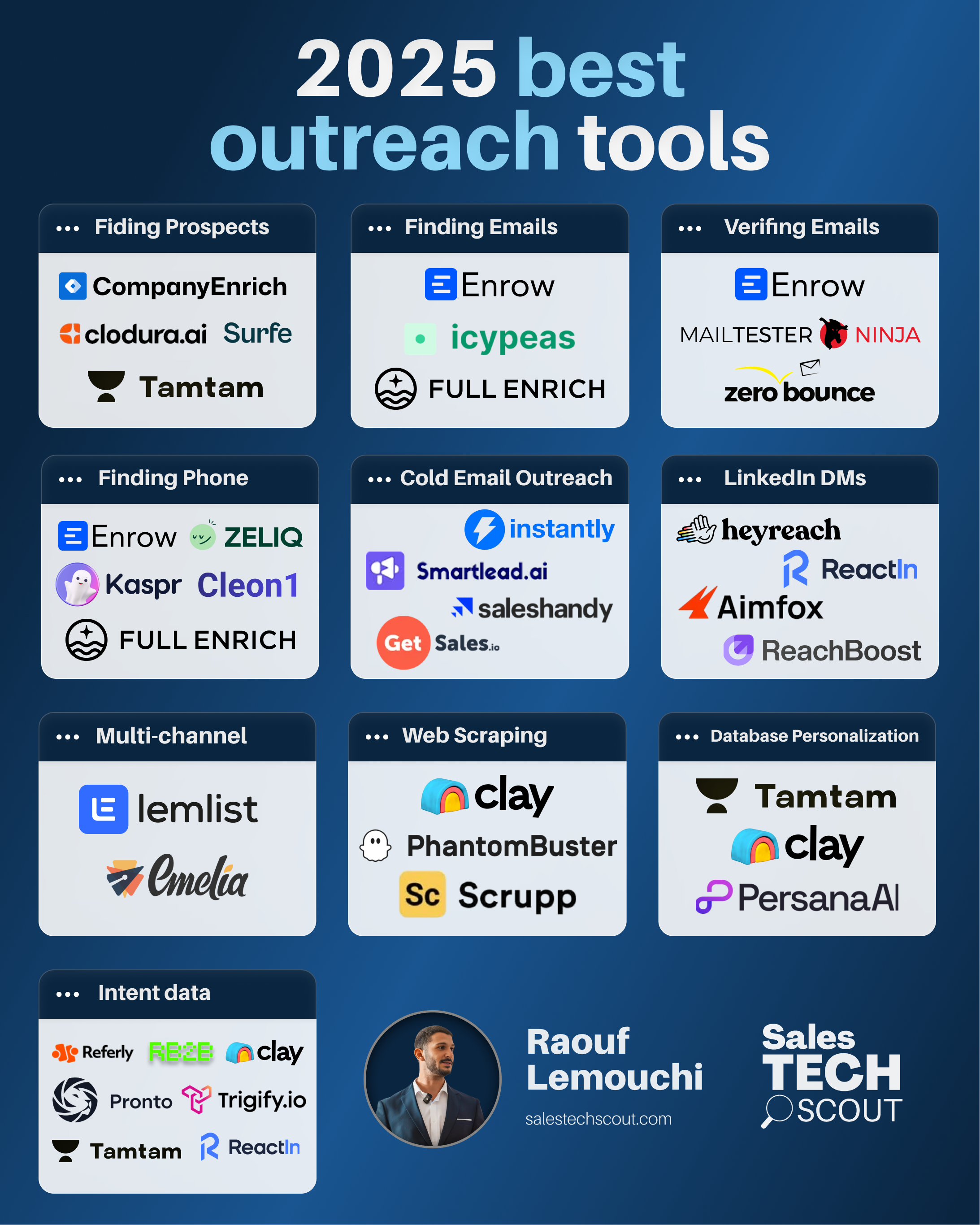
How to Break Into Sales Enablement: Practical Career Advice
Sales enablement attracts professionals from multiple backgrounds. Former sales reps bring frontline experience and credibility with sellers. Marketing professionals understand content and positioning. Learning and development specialists excel at training design. Operations experts bring process optimization and analytics skills.
No single path dominates, but certain approaches increase your chances of landing that first enablement role.
Build Relevant Experience in Your Current Role
The fastest path to enablement starts where you are now. Look for opportunities to develop enablement skills in your existing position.
If you're in sales, volunteer to help onboard new team members. Create training materials or best practice guides. Organize lunch-and-learn sessions where top performers share their approaches. These initiatives demonstrate enablement aptitude while building a track record you can reference in interviews.
If you're in marketing, focus on sales-facing content. Work closely with the sales team to understand what materials they actually need. Track content usage and gather feedback on effectiveness. This sales-marketing alignment is exactly what enablement teams do.
If you're in operations or analytics, build dashboards that help sales teams understand their performance. Create reports that identify coaching opportunities. Design processes that make selling more efficient. This data-driven approach mirrors core enablement responsibilities.
Document everything you do. Take screenshots of materials you create, collect testimonials from colleagues who benefited from your work, and quantify results whenever possible. This portfolio proves your capabilities when you're ready to transition.
Develop Core Enablement Skills
Formal education helps but isn't required. Most successful enablement professionals learn through self-study, on-the-job experience, and targeted skill development.
Sales methodology training matters significantly. Consider getting certified in popular frameworks like MEDDIC, Challenger Sale, or Sandler Selling System. These certifications cost $1,000-$3,000 but demonstrate serious commitment to sales excellence.
Instructional design skills separate good enablement from great. Online courses in adult learning theory, training development, and educational technology strengthen your ability to create programs that actually change behavior. Platforms like LinkedIn Learning or Coursera offer affordable options.
Technology proficiency grows through hands-on practice. Set up free trials of enablement tools, build sample workflows, and explore how different platforms integrate. Many vendors offer free training and certification programs. Complete these to add credentials to your LinkedIn profile.
Analytics and data visualization courses help you extract and present insights. Learn SQL basics, master Excel or Google Sheets, and explore visualization tools like Tableau or Looker. The ability to turn raw data into actionable insights makes you invaluable to enablement teams.
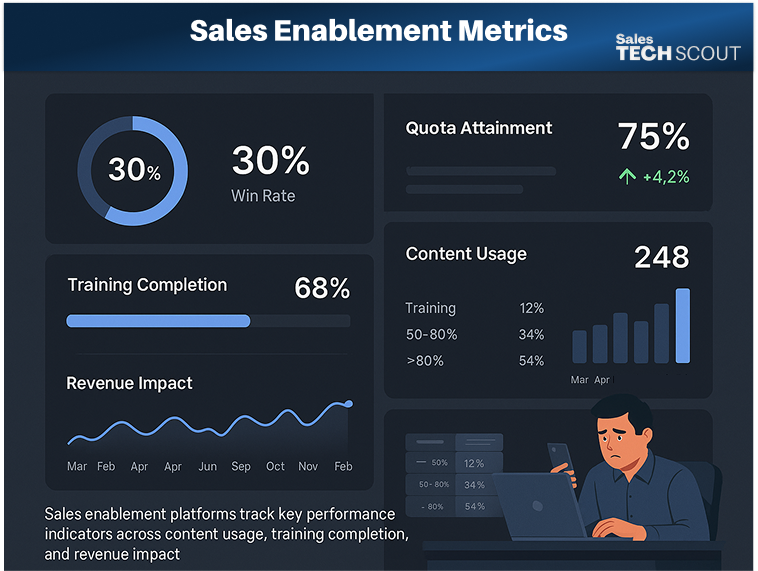
Network in the Enablement Community
Sales enablement has a strong professional community. Active participation helps you learn from practitioners, hear about job opportunities, and build relationships that accelerate your career.
Join LinkedIn groups focused on sales enablement. Participate in discussions, share insights, and connect with enablement leaders. The Sales Enablement Society and Revenue Enablement Society maintain active communities worth engaging.
Attend virtual conferences and webinars. Many are free or low-cost, providing access to enablement thought leaders and best practice sharing. Take notes on frameworks and approaches you can apply in your current role.
Follow enablement influencers and thought leaders on social media. Comment thoughtfully on their posts, share their content, and engage in conversations. This visibility helps when you're applying for roles.
Consider starting your own content creation. Write LinkedIn posts about enablement topics, share lessons learned from your experience, or create how-to guides on specific enablement skills. This content demonstrates expertise and attracts recruiter attention.
Target Companies at the Right Stage
Not all companies offer equal opportunities for breaking into enablement. Target organizations where you're most likely to land that first role.
High-growth B2B companies between 50-500 employees often create their first dedicated enablement roles. These organizations outgrow informal training and need structure as they scale. Your willingness to build from scratch and wear multiple hats becomes an advantage rather than a gap.
Companies hiring multiple sales reps need enablement support. Look for job postings showing aggressive sales hiring. Growing sales teams create urgent needs for onboarding, training, and process documentation.
Organizations with recent funding often invest in sales infrastructure including enablement. Check Crunchbase for companies that closed Series A, B, or C rounds in the last 6-12 months. These firms have capital to build out their revenue teams properly.
Companies selling complex B2B products need strong enablement because their sales cycles are long and require deep product knowledge. SaaS companies, technical services firms, and enterprise software vendors all fit this profile.
Position Your Transferable Skills
When you're making the transition, highlight how your background translates to enablement needs.
Former sales reps should emphasize quota attainment and customer-facing success, understanding of sales processes and buyer psychology, credibility with sellers who respect proven performers, and ability to identify what actually works versus theoretical approaches.
Marketing professionals can highlight content creation and messaging expertise, understanding of buyer journeys and personas, experience with martech stacks and data analysis, and ability to align sales and marketing activities.
Learning and development specialists should stress instructional design capabilities and adult learning theory, training program development and delivery, measurement of learning outcomes, and change management and adoption strategies.
Operations professionals can emphasize process optimization and efficiency improvement, data analysis and reporting capabilities, technology implementation and integration, and project management and cross-functional coordination.
Craft your resume and LinkedIn profile to showcase these transferable skills. Use enablement language even when describing non-enablement work. Instead of "trained new sales reps," write "designed and delivered onboarding program that reduced ramp time by 30%." This framing helps recruiters see you as an enablement professional.
Consider Contract or Freelance Work
Breaking in through full-time roles can be challenging. Contract work offers an alternative path that builds experience and credibility.
Many companies need project-based enablement support for specific initiatives like new product launches, sales kickoff events, training program development, or content creation sprints. These projects let you prove your value without the company committing to a full-time hire.
Freelance platforms and consulting marketplaces sometimes list enablement projects. Start with smaller engagements to build your portfolio, then leverage success stories to win larger contracts.
Contract work often converts to full-time employment. Once you demonstrate impact, companies frequently offer permanent positions rather than starting a search for external candidates.
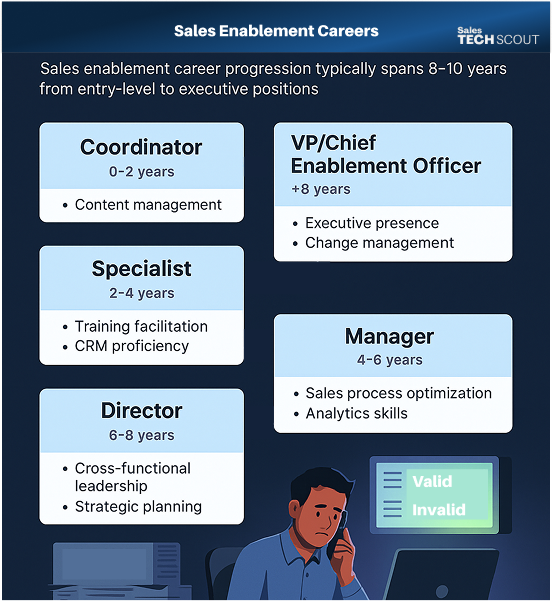
Frequently Asked Questions About Sales Enablement Jobs
What's the difference between sales enablement and sales operations?
Sales operations focuses on systems, processes, and infrastructure including CRM administration, territory and quota planning, sales compensation and commission management, deal desk and approvals, and forecasting and pipeline management.
Sales enablement focuses on the people development side including training and coaching, content creation and management, sales methodology and best practices, onboarding programs, and skills development.
Think of sales ops as maintaining the machine and enablement as making the people running that machine more effective. Many organizations combine these functions under Revenue Operations teams, but the skill sets differ significantly.
Do I need sales experience to work in enablement?
Sales experience helps but isn't always required. Many successful enablement professionals came from sales and bring credibility and practical knowledge that resonates with sellers.
However, professionals from marketing, learning and development, or operations backgrounds also succeed in enablement by leveraging their unique skills in content creation, instructional design, or process optimization.
What matters most is understanding the sales process, demonstrating empathy for seller challenges, and showing ability to translate knowledge into practical tools and training that change behavior.

How is sales enablement different from sales training?
Sales training is one component of enablement. Training focuses specifically on teaching skills like objection handling, discovery questions, or product knowledge through structured learning experiences.
Sales enablement encompasses training but also includes content development, technology implementation, process design, performance analytics, and cross-functional coordination. Enablement is the strategic function; training is one of the tactical approaches enablement uses.
What certifications or education do I need?
No specific certifications are required for sales enablement roles. However, several credentials can strengthen your profile including sales methodology certifications like MEDDIC, Challenger, or Sandler, instructional design certificates from universities or organizations, enablement-specific certifications from the Sales Enablement Society, and product or industry-specific credentials relevant to your target companies.
These certifications demonstrate commitment and knowledge but matter less than proven ability to drive results through enablement programs.
Can sales enablement jobs be fully remote?
Yes, many sales enablement roles are fully remote, especially post-pandemic. Enablement work adapts well to remote environments since much of it involves virtual training, digital content creation, and online collaboration.
However, some companies prefer enablement teams on-site or hybrid to facilitate spontaneous collaboration and build stronger relationships with sales teams. Remote opportunities are most common at companies with distributed sales forces where in-person work provides limited advantage.
How do I know if sales enablement is right for me?
Sales enablement fits well if you enjoy teaching and seeing others succeed, like creating structure and process from chaos, appreciate variety in daily work, feel comfortable with ambiguity and changing priorities, want to influence revenue without carrying a quota, and prefer collaborative work across multiple teams.
Enablement might not fit if you need clear, predictable daily routines, prefer deep focus on single projects, dislike navigating organizational politics, want direct control over outcomes, or aren't comfortable with teaching and public speaking.
The best way to know is trying enablement work in small doses. Volunteer for training projects in your current role. Offer to help with sales onboarding. These experiments reveal whether the work energizes or drains you.
Conclusion: Sales Enablement as a Career Path
Sales enablement represents one of the fastest-growing career paths in B2B. As companies recognize that their competitive advantage comes from how well their people execute, investment in enablement will only increase.
The role offers unique advantages. You impact revenue without carrying quota pressure. You work cross-functionally, building diverse relationships and understanding the full business. You blend strategic thinking with hands-on execution. You see direct results from your work as reps successfully apply what you teach them.
The career path also provides strong progression. Start as a coordinator managing programs. Grow into manager roles designing initiatives. Advance to director positions setting strategy. Reach VP and executive levels shaping how entire organizations enable their revenue teams.
Compensation reflects this importance. From entry salaries around $50,000 to executive packages exceeding $250,000 plus equity, enablement pays well for skilled practitioners who demonstrate business impact.
The field isn't without challenges. Proving ROI requires sophisticated analysis. Getting adoption demands political savvy. Balancing reactive requests with strategic initiatives tests prioritization skills. But these challenges make the work interesting rather than insurmountable.
If you're considering sales enablement, start building relevant skills today. Create training materials in your current role. Master sales technology platforms. Develop content that helps colleagues succeed. Build a portfolio demonstrating your capabilities.
For hiring managers, recognize that great enablement professionals come from diverse backgrounds. Look beyond traditional paths. Value transferable skills like instructional design, content creation, analytics, and technology proficiency alongside sales experience.
Sales enablement will only become more critical as B2B buying continues evolving. Sellers need more sophisticated skills, better tools, and stronger support to navigate increasingly complex sales cycles. Organizations that invest in enablement will outperform those that don't.
The question isn't whether to build enablement capabilities. It's whether you want to be part of building them.
Additional Resources and Next Steps
Explore Sales Enablement Tools:
- Visit SalesTech Scout's Tool Finder to discover 300+ analyzed sales tools
- Test platforms like Smartlead, Lemlist, or Attio to build technology proficiency
- Experiment with data enrichment tools like Prospeo, Enrow or FullEnrich
Join Enablement Communities:
- Sales Enablement Society (professional membership organization): example
- Revenue Enablement Society (focus on broader GTM enablement)
- LinkedIn sales enablement groups and discussions
Continue Learning:
- Follow sales enablement thought leaders on LinkedIn
- Read enablement blogs and publications
- Attend sales enablement conferences and webinars
Ready to start your enablement career? Begin building your portfolio today.
Subscribe to Our Newsletter
To Never Miss a Thing






.avif)


